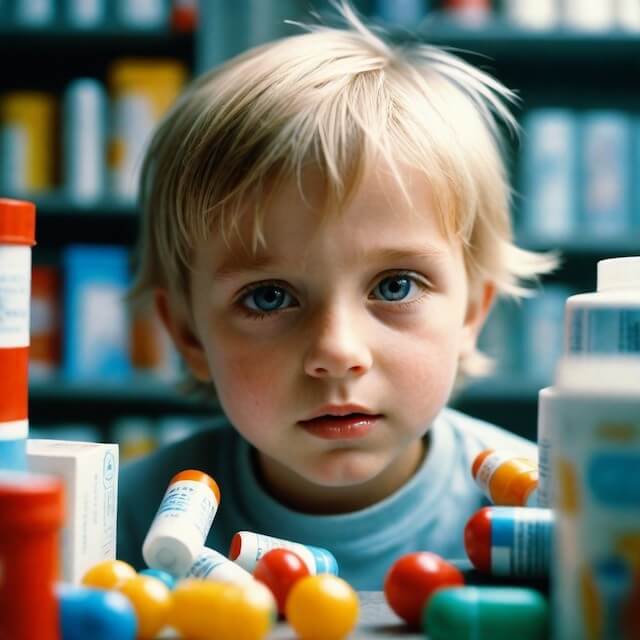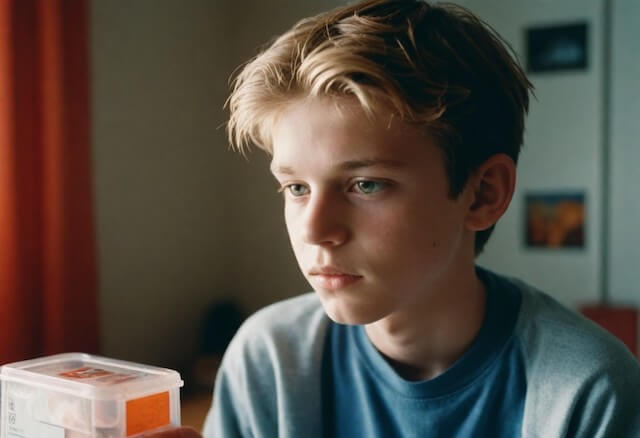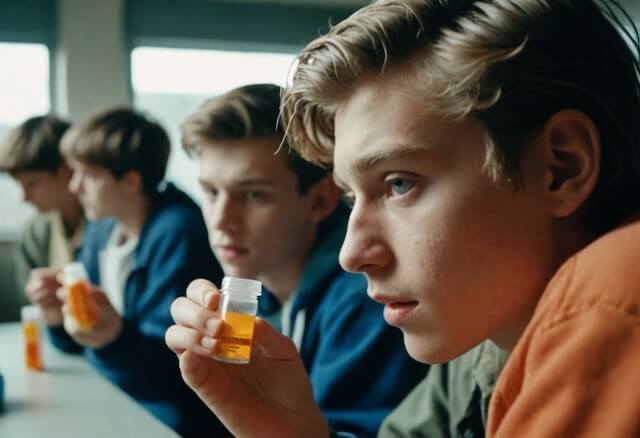The prescribing of psychotropic medications like benzodiazepines and stimulants for children has been on the rise, with these drugs being used as first-line treatments for various mental health disorders despite limited information on their efficacy in this age group. These medications work by altering levels of neurotransmitters such as serotonin and dopamine in the brain, but children can be more sensitive to their side effects compared to adults .
What are the real risks associated with common psychotropic drugs prescribed to children, including potential psychological impacts and physical health risks?
Is there even a debate surrounding the efficacy and over prescription of these medications, and discusses non-pharmacological alternatives for treating mental health issues in children?
Understanding the Psychiatric Medications for Kids
Despite limited information on efficacy in children, psychotropic medications are commonly prescribed as a first-line treatment for various psychiatric diagnoses, with increasing prescribing rates and the number of medication types per child. There is uncertainty regarding how children react to multiclass psychotropic regimens, and a lack of evidence regarding concomitant psychotropic medication administration and its safety has been cited as a concern.
The safest drugs for treating depression in children and adolescents are escitalopram and fluoxetine, while lurasidone is the safest for treating psychosis. Methylphenidate is the safest for treating ADHD, and lithium is the safest mood stabiliser. Researchers had the most concerns about the safety of venlafaxine, olanzapine, atomoxetine, guanfacine, and valproate for children and adolescents.

Many psychotropics prescribed to children are unlicensed or off-label, meaning they are used for purposes other than for which they are officially approved. The situation is improving with the establishment of Paediatric Pharmacology Research Units (PPRUs) and Research Units on Paediatric Psychopharmacology (RUPPs). Before starting medication, clinicians should discuss:
Target symptoms
Risks of untreated illness
Potential benefits and known risks of medication
Side effects and FDA warnings
On-label or off-label prescribing
The likelihood of potential adverse effects (AE) from psychotropic medications in children may be predictable based on client characteristics, such as the number of DSM-IV categories diagnosed, impulsiveness, and uncooperativeness. Predicting potential AE during initial assessment can be useful in directing and monitoring treatment, as well as preventing serious events related to medication use.
Approximately 33% of children in foster care take at least one psychotropic medication, and they are two times more likely to receive higher than recommended doses of antipsychotics than other kids. Only 8% of foster children prescribed antipsychotics receive baseline screening for side effects.

Pharmacists play a critical role in ensuring evidence-based prescribing, identifying and managing drug interactions, and monitoring side effects, especially as these medications behave differently in children than adults. Certain populations, such as foster children and those from lower-income families, are at greater risk for polypharmacy. Children younger than 5 years are most likely to visit the ED for ADEs. Pharmacists can help combat polypharmacy by:
Identifying a single psychotropic medication indicated for several psychiatric conditions
Using established state guidelines to develop and implement protocols for prescribing psychotropic medications
Monitoring medication levels, labs, and assessing extrapyramidal effects 5
The two most prescribed psychotropics are:
Methylphenidate (MPH)
Selective Serotonin Reuptake Inhibitors (SSRIs)
Little is known about their long-term impact, and the dramatic rise in prescriptions over the last ten years has raised concern about the potential for harm.
The Psychological Impact of Medications

Psychotropic medications can have devastating and life-altering effects on children and young adults when improperly administered, including chronic diseases, hallucinations, weight gain, organ damage, and suicidal thoughts. Children often report feeling like “zombies,” unable to function in school or engage in outside activities due to the adverse effects of psychotropic medications.
A study titled “Adverse Effects of Psychotropic Medications in Children: Predictive Factors” was conducted by Ajit Ninan, Shannon L. Stewart, Laura A. Theall, Shehan Katuwapitiya, and Chester Kam. The research aimed to identify mental health characteristics of children at highest risk of experiencing potential adverse effects (AE) from psychotropic medications.
The study found that:
The total number of potential AE was positively predicted by the number of DSM-IV categories diagnosed, as well as behavioural symptoms of impulsiveness and uncooperativeness.
Children in foster care are twice as likely to receive higher than recommended doses of antipsychotics compared to other children.
Only 8% of foster children prescribed antipsychotics receive baseline screening for side effects 7.
Children in government systems often exhibit behaviours resulting from abuse and trauma, leading to the use of psychotropic drugs as a form of chemical restraint.
Hundreds of children, some as young as pre-schoolers, are at risk of serious harm due to the lack of mental health treatment plans and monitoring of prescribed medications.
Physical Health Risks Associated with Psychotropic Drugs
Children can be more sensitive to adverse effects (AE) from psychotropic medications compared to adults, and the severity of these AE may lead to clients or their parents refusing to continue pharmacologic therapy. Overuse of psychotropic drugs creates short-term health risks such as increased heart rate, blood pressure, sleepiness, sedation, tremor, anxiety, dizziness, confusion, changes in behaviour, and seizures.
A recent systematic review offers guidance on the safety of four major classes of psychotropic drugs given to children and adolescents, focusing on adverse events linked to 80 medicines in the categories of antidepressants, antipsychotics, anti-ADHD medications, and mood stabilizers. The study found the following common issues:
Antidepressants: Nausea, vomiting, and stopping a drug due to side effects. Escitalopram (Lexapro) and fluoxetine (Prozac) were less likely than others to cause adverse effects.
Antipsychotic medicines: Drowsiness, abnormal muscle movements, and weight gain. Lurasidone (Latuda) was less likely than others to cause adverse effects.
Anti-ADHD medicines: Loss of appetite and insomnia. Methylphenidate (Ritalin, Concerta) was less likely than others to cause adverse effects.
Mood stabilizers: Drowsiness and weight gain. Lithium was less likely to cause adverse effects, although its long-term effects might be underrepresented.

When improperly administered, psychotropic medications can have severe side effects, including chronic diseases such as diabetes, irreversible movement disorders, hallucinations, weight gain, organ damage, and suicidal thoughts. These drugs are often used as a form of “chemical restraint” to control behaviour, rather than treating diagnosed mental health conditions, and this frequently occurs without proper oversight or informed consent.
Despite the dramatic rise in prescriptions of psychotropic medications for children over the last decade, understanding their efficacy, specificity, and adverse effects in paediatric populations lags behind what is known in adults. This has raised concerns about the potential for harm, especially with the two most prescribed psychotropics, MPH and SSRIs, which have very little research into their safety and efficacy with children and young people. In the absence of reliable data, clinicians may resort to prescribing off-label.
A study using data from the National Ambulatory Medical Care Survey (NAMCS) found that:
Rates of visits resulting in a psychotropic prescription for adolescents aged 14 to 18 years increased from 3.4% in 1994-1995 to 8.3% in 2000-2001.
These trends were evident for both males and females, with average annual growth rates for psychotropic prescriptions being much higher after 1999.
By 2001, one out of ten office visits by adolescent males resulted in a prescription for a psychotropic medication.

The increase in prescription rates may be associated with changing thresholds of diagnosis and treatment, the availability of new medications, and changes in federal regulatory policies concerning the promotion of medications by the pharmaceutical industry. Recent trends from large population-based studies show substantial growth in paediatric and adolescent use of antidepressants and stimulants, with the numbers of children under 19 years taking one or more behavioural drugs rising over 20% between 2000 and 2003. Spending on medications to treat attention deficit disorder rose 183%, antidepressants 27%, and medications for autism and conduct disorders more than 60% in that period. Notably, the most commonly prescribed psychiatric drugs have not been approved by the FDA for people under 18.
The situation is particularly concerning for children in foster care:
33% of children in foster care are taking at least one psychotropic medication.
Children in foster care are two times more likely to receive higher than recommended doses of antipsychotics than other kids.
Only 8% of foster children prescribed antipsychotics receive baseline screening for side effects.
A study on psychotropic medication dispensation among children and adolescents with type 1 diabetes (T1D) showed an increasing trend, with the annual period prevalence of any psychotropic medication increasing from 0.85% to 3.84% among children and from 2.72% to 13.54% among adolescents with T1D.
Non-pharmacological Alternatives to Medication
Attorneys and judges working with children in the child welfare and juvenile justice systems can advocate for alternative treatments and strengthened oversight protocols for psychotropic medication use. The Missouri and California models provide a roadmap for protecting the rights of foster youth related to psychotropic medication, including advocating for meaningful oversight systems and filing lawsuits to reform medication practices.
Non-pharmacological treatments for psychiatric conditions in children have evolved significantly, offering a range of options:
Psychosocial interventions: behavioural intervention, parent training, peer relationship training, social skills training, and school/classroom-based intervention/training.
Body-focused interventions: body-oriented, yoga-based, physical exercise, sleep intervention, and mindfulness-based interventions (MBIs).
Structured physical exercises have moderate to large effects on ADHD symptoms, anxiety, executive function, and social disorders.
Sleep intervention reduces symptom severity, sleep disturbances, and improves psychological functioning.
MBIs vary in methods, quality, and dosage but have shown improvements in attention, emotion regulation, and social relationships.
Cognitive/neuro-cognitive interventions: CT/computer attention training, working-memory training, attention training, neurofeedback (NF) training, and biofeedback intervention.
Computer-based attention/cognitive functioning training is globally preferred due to its structured content and methodology.
Cognitive-behavioural interventions: coping skills training, play-based therapies, and group cognitive-behavioural therapy.
Brief, non-pharmacological interventions for paediatric anxiety, such as in-vivo exposures for specific phobias, CBT with social skills training, and CBT-based parent training, have been found effective.
Reengineering evidence-based intervention strategies, such as modifying protocols for brevity or developing minimal interventions, is a focus of current research.
Other non-pharmacological treatments include psychotherapy (psychodynamic, cognitive, supportive, crisis intervention), psychosocial interventions (relapse prevention, self-help groups, harm reduction), mental health assessment, therapy, skills building, parenting assistance, family therapy, and engaging youth. Promising practices include Child-Parent Relationship Therapy (CPRT) for ages 3-8, Dyadic Developmental Psychotherapy for ages 5-17, and Infant and Toddler Mental Health Programs from birth to age. When choosing interventions, clinical expertise, best available clinical evidence, and the patient’s values and expectations should be considered.

The use of psychotropic medications in children is a complex issue that requires careful consideration of both the potential benefits and risks. While these medications can be effective in treating certain mental health conditions, they can also have significant psychological and physical side effects, especially when improperly administered or monitored. It is crucial for healthcare providers, parents, and caregivers to be aware of these risks and to consider non-pharmacological alternatives, such as psychotherapy, psychosocial interventions, and body-focused therapies, when appropriate.
Ultimately, the decision to use psychotropic medications in children should be made on a case-by-case basis, taking into account the individual child’s needs, the severity of their symptoms, and the potential risks and benefits of treatment. By working together and advocating for stronger oversight and informed consent protocols, we can ensure that children receive the safest and most effective care possible. We encourage our readers to comment below and share their thoughts, experiences, and insights on this important topic.
FAQs
Q: What are the potential harmful effects of psychotropic drugs on children? A: When psychotropic medications are prescribed or used improperly in children, they can cause severe and long-lasting harm. Some of the more serious side effects include chronic conditions like diabetes, irreversible movement disorders, hallucinations, significant weight gain, damage to internal organs, and an increased risk of suicidal thoughts.
Q: What ethical issues arise from prescribing psychiatric medications to minors? A: There are significant ethical concerns when it comes to medicating children for psychiatric reasons. These concerns revolve around the idea that medicating a child can interfere with their natural development by controlling their behaviour, thoughts, or emotions. This can potentially deprive them of learning critical life skills such as self-efficacy, responsibility, and self-regulation.
Q: What are the risks associated with taking psychotropic medications? A: The risks of taking psychotropic medications can range from common side effects like drowsiness, dizziness, increased saliva production, and changes in libido or sexual function, to rare but severe effects such as mental or mood changes (including hallucinations and suicidal thoughts), slurred speech, coordination problems, difficulty walking, and memory issues.
Q: Is administering medications to children for mental health issues considered appropriate? A: Medications can be an important part of a comprehensive treatment strategy for children with mental health issues. This approach typically combines drug therapy with psychotherapy, family therapy, and possibly educational and community support interventions. Dr. Andres S. Martin, a psychiatrist at the Yale Medicine Child Study Centre, emphasises that drugs should be one component of a holistic treatment plan.

